Farming barramundi alongside tiger prawns can increase profits without reducing productivity, according to a growing number of Indonesian aquaculture operators.
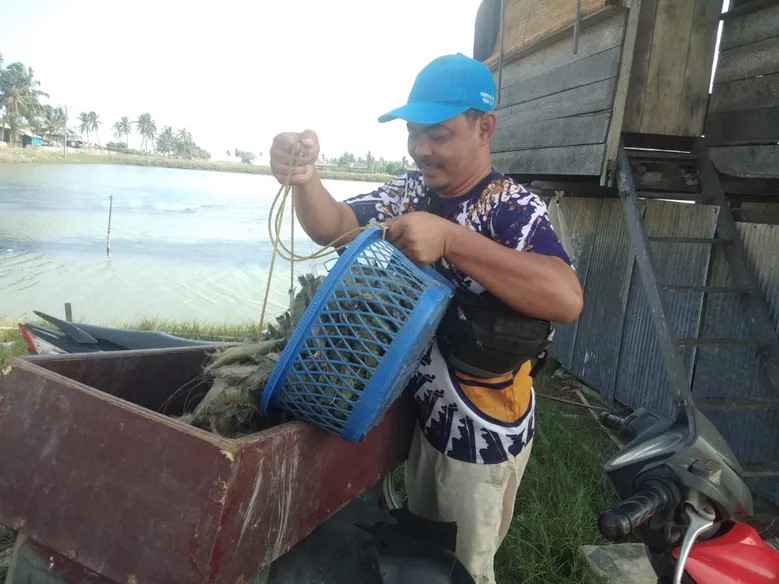
Indonesian prawn farmers are turning to polyculture to boost profits
Increasing aquaculture productivity doesn’t always rely on the adoption of sophisticated technology or massive investment, as a group of farmers in Pinrang-South Sulawesi are showing in their innovative co-culture of tiger prawn and barramundi.
While polyculture systems are widely practised in Indonesia, what makes this example unique is that it only came about by chance – after a traditional tiger prawn farmer named Abdul Waris Mawardi found barramundi in his monodon pond. The fish must have arrived as juveniles in the sea water intake and then grown alongside the prawns over the course of the cycle.
Barramundi tend to become predatory when they do appear in traditional brackish water ponds, decimating the farmers’ target stocks of tiger prawn and milkfish. However, on several occasions Mawardi found that barramundi could grow and can be harvested together with the crustaceans without decreasing prawn productivity. He therefore thought that the system could increase his productivity, if managed properly.
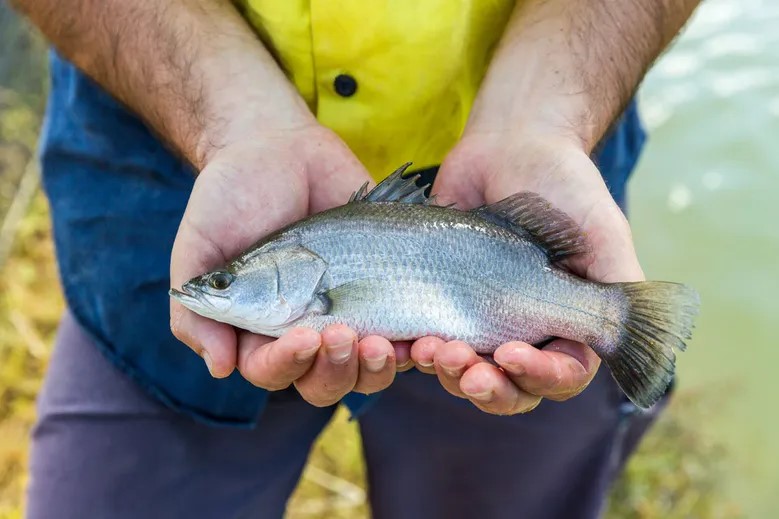
Farmers have found that barramundi could be co-cultured with prawns if managed properly
Advantages of polyculture
Both monodon and barramundi are high value species. Traditionally produced prawns in Pinrang are branded as eco-shrimp and sold to the Japanese market via PT. Atina (Alter Trade Indonesia). The farm gate price for monodon in Pinrang ranges from 59,000 – 115,000IDR per kg (€3.61 – €7.03 per kg), depending on the size at harvest. Meanwhile, barramundi are mainly sold locally, for a farm gate price for fish of 250 grams ranging from 30,000 – 50,000IDR per kg (€1.83 – €3.06 per kg).
In addition to achieving a good price, barramundi are well suited for polyculture with monodon, reaching market size in around 3-4 months and having tolerance to a range of water qualities and cultivation systems.
Mawardi, who is the Coordinator of Pokdakan (farmers group) Cempae-Pinrang, has been developing polyculture of tiger prawn and barramundi in ponds for three years. Before cultivating barramundi as a second species in polyculture, Mawardi and other farmers produced tiger prawn and milkfish.
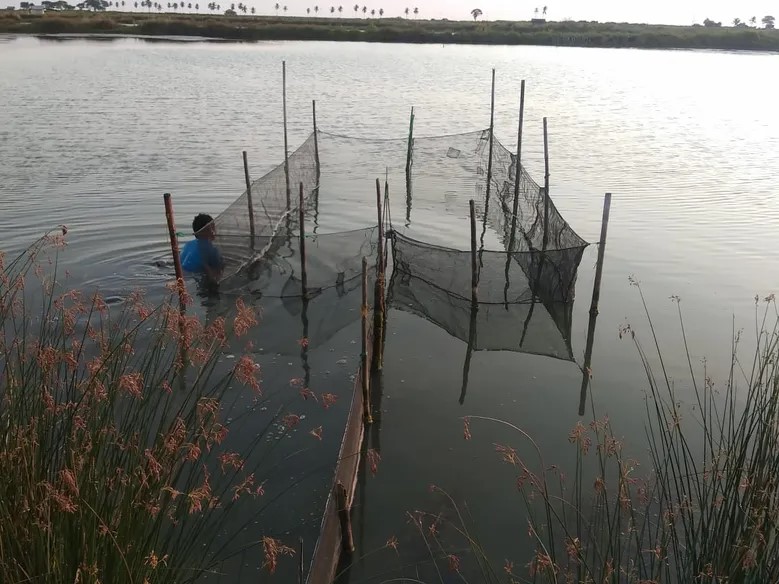
Mawardi has developed the polyculture method over three years
However, he says that the productivity of tiger prawn, in terms of survival rate and its size, is higher if cultured with barramundi. This is because barramundi can eat other wild fish that appear in the ponds – including tarpon (Megalops cyprinoides), tilapia (Oreochromis mossambicus), and payus (Elops hawaiensis).
There are several things that must be considered to ensure an optimal harvest – including preparation of the pond, quality and size of seed, density of each species and feed management.
Pond preparation
Mawardi explains that pond preparation is actually similar to other traditional polyculture systems. The key ingredients are the drainage of ponds; the removal of pests using saponins; the use of organic fertilisers that consist of C-organic Fe, Mn, and Zn to grow the natural feed for the species cultured; and liming to ensure the pH of the soil ranges from 6-7.
Ponds are ready to stock when natural feed in the form of Phronima sp and plankton appears. Phronima’s presence can be seen in plain sight by observing the bottom of the pond near the embankment. If producers examine a handful of soil from the bottom of the pond, phronima will look like mosquito larvae. Meanwhile, the presence of plankton can be seen from the greenish-brown colour of the water.
Seed stocking
The seed stocking process plays a very important role in tiger prawn and barramundi polyculture and will determine the ultimate success of cultivation.
To avoid them falling prey to barramundi, larger sized tiger prawns – of around 5-8 cm – must be stocked. Farmers are recommended to buy PL 12 from the hatchery then raise them for 15 days in the nursery pond, or buy larger seed directly from nursery farmers. Some farmers in Pinrang-South Sulawesi specialise in producing these larger seed.
For every hectare of pond, farmers usually stock 88,000 tiger prawns and then grown these for around 120 days. Mawardi and his group split this stocking process into three phases. In the first phase, farmers stock 35,000 seeds. The second is carried out 30 days later with 20,000 more. And the final phase is carried out 60 days after the initial stocking and involves 33,000 seeds. Meanwhile, the stocking of 3,500 barramundi juveniles is carried out after approximately 90 days of the first stocking.
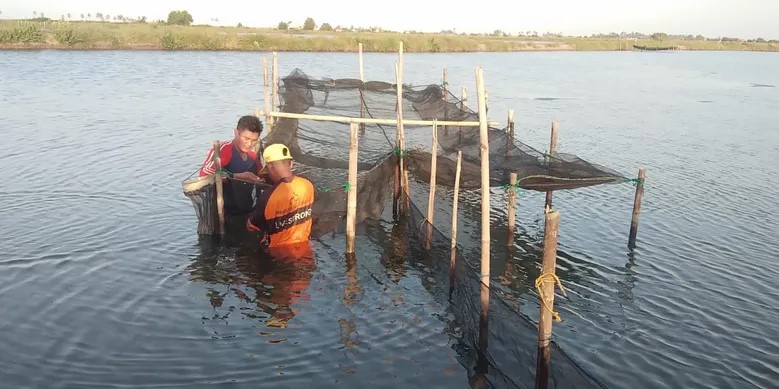
Like tiger prawn, the barramundi are stocked at a larger size (5-10 cm). Naturally occurring juveniles are usually 2-4 cm, so must be raised in a nursery pond until they reach the desired size.
Feed management
In this polyculture system, barramundi are only fed trash fish or baby tilapia. Meanwhile, the tiger prawn rely entirely on natural feed in the form of Phronima sp, aquatic plants and other microorganisms and can therefore be labelled organic.
In early stocking, barramundi usually don’t like to eat fresh feed, as its natural behaviour is to eat live fish, but they can be trained to eat fresh feed. Farmers can do this little by little until the barramundi are used to eating it, which takes about a month. Mawardi recommends feeding the barramundi once in the morning and once in the afternoon, at one fixed spot at the pond.
Partial harvest
Like the gradual stocking process, harvesting is also carried out in phases. The first harvest is carried out 60 days after the first stocking and then it is conducted twice a month at high tide. The harvesting process is carried out using net traps (bagang-bagang) with 5 cm mesh. This allows the smaller shrimp, that were stocked later, to remain in the pond. Meanwhile, any barramundi caught should be released and harvested at the end of the cultivation period.
With these systems of stocking and harvesting, farmers can produce 384 kg of tiger prawns per hectare at an average size of 45 prawns per kg. The farm gate price for that size is around 83,000 IDR/kg (€5.07/kg), so the farmers can earn 31.8 million IDR (€1,942) from just the prawns. At the same time, 360 kg of barramundi can be harvested, at average size of six fish per kg. At this size, the farm gate price is about 32,500 IDR per kg (€1.99/kg), which means the farmers’ income from barramundi can reach 11.7 million IDR (€715) each cycle.
Government support
The polyculture of tiger prawn and barramundi that was carried out by Mawardi and his 750 group members has become a model for other groups in that area, which are part of an eco-farming development initiated by the government which covers 1,000 hectares.
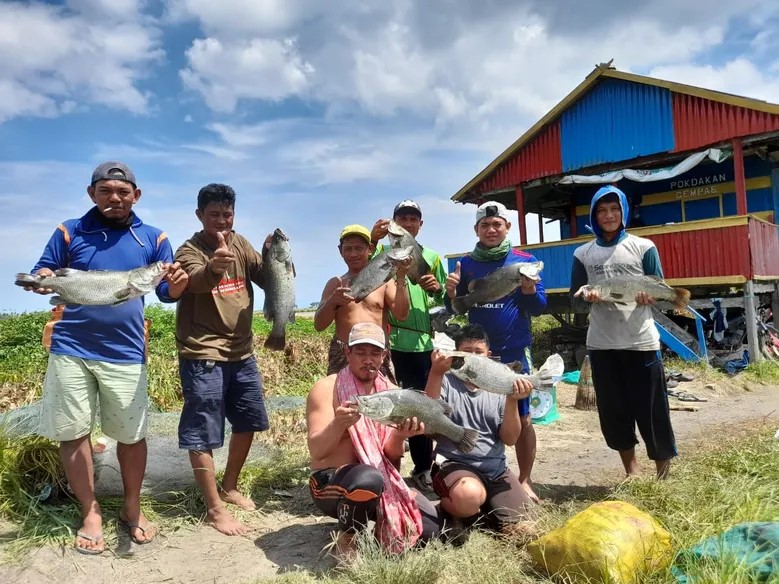
This polyculture system is also supported by Ambon Mariculture Development Centre (Balai Perikanan Budidaya Laut/BPBL) through the provision of good quality barramundi juveniles, where previously farmers relied on from natural catches. Alongside 2019-2021, BPBL Ambon has distributed 250,000 barramundi juveniles to the farmers to date.
By Minapoli
Biên dịch: Huyền Thoại – Công ty TNHH PTTS Bình Minh
Xem thêm:
- Global Shrimp Production To Surpass 5 Million MT in 2022, CP Foods’ Robin McIntosh Predicts
- Shrimp And Salmon Farmers Are Set For A Year Of Profits And Plenty
- Survival Of Pacific White Shrimp Juveniles After Exposure To Critical Oxygen Levels In Biofloc Culture

 Tiếng Việt
Tiếng Việt 中文 (中国)
中文 (中国)